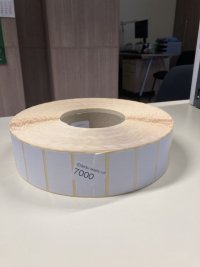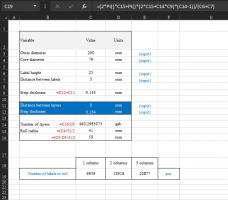Hello!
Please accept my apology if this is not the right category to post such a question.
Problem:
We are working in the field of manufacturing self-adhesive labels and recently I've been tasked with creating a formula for a roll outer diameter calculation.
Picture of the roll:

Known variables:
1. Strip layer thickness, µm
2. Roll (inner) core diameter, mm (strip starting point?)
3. Strip length, m (for strip ending point?). Calculated: label count * label height + distance between labels
4. Distance between layers = 0
I've made a simplified formula in Excel, however, it seems to be off by a margin of ~2%.
I would highly appreciate it if someone here could help me with this problem.
Thanks!
- Artūrs, the guy who did not pay the required attention to math at Uni.
Please accept my apology if this is not the right category to post such a question.
Problem:
We are working in the field of manufacturing self-adhesive labels and recently I've been tasked with creating a formula for a roll outer diameter calculation.
Picture of the roll:

Known variables:
1. Strip layer thickness, µm
2. Roll (inner) core diameter, mm (strip starting point?)
3. Strip length, m (for strip ending point?). Calculated: label count * label height + distance between labels
4. Distance between layers = 0
I've made a simplified formula in Excel, however, it seems to be off by a margin of ~2%.
I would highly appreciate it if someone here could help me with this problem.
Thanks!
- Artūrs, the guy who did not pay the required attention to math at Uni.


